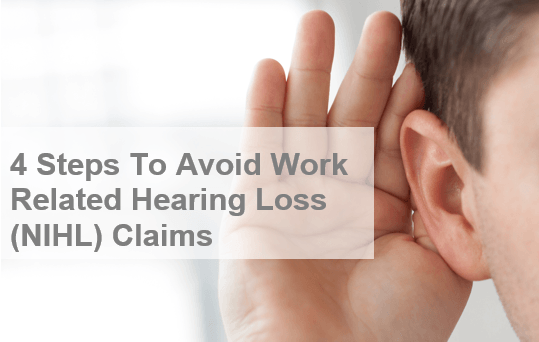MANAGE THE NOISE
=
MANAGE YOUR RISK
Do you need to raise your voice at work to be heard by others close by?
Do you need to raise the volume of the TV or radio at home higher than others?
These are early signs of possible hearing damage caused by exposure to noise hazards. Offices, factories, warehouses and outdoor work environments can all be affected.
ABL’s Occupational Wellness Manager and staff are committed to helping our client companies mitigate these safety hazards, and ensuring workers can hear what you need to say in order to stay safe. Hearing loss claims can result in non-economic loss compensation awards.
GOOD NEWS! Noise control on the worksite coupled with the right hearing protectors, will help safeguard your workers’ hearing. Noise can also interfere with communications, concentration, and ultimately affect work site safety, resulting in accidents.
In this blog, we include a quick self-assessment, and 3 Management Strategies to manage the workplace noise levels and associate injury risk.

It is time to think about the effect of noise and the risk of related potential claims at your worksite if the answer is yes to any of these questions:
- Do people have to raise their voices to be heard by a co-worker an arm’s length away?
- Do people who work in noisy environments have ringing in their ears at the end of a shift?
- Do they find when they return home from work that they have to increase the volume on their car radio higher than they did when they went to work?
- Does a person who has worked in a noisy workplace for years have problems understanding conversations at parties, restaurants, or in crowds where there are many voices and “competing” noises?
If there is a noise problem in a workplace, then a noise assessment or survey should be undertaken to determine the sources of noise, the amount of noise, who is exposed and for how long.
Step 1: Conduct an initial noise assessment to know what noise levels are on the worksite
Hint: Download a free “SPLnFFT Noise Meter” to your phone or tablet with the following applications: frequency analyzer, frequency meter, test signal generator, dosimeter (cost is usually between $40 to $100)
Step 2: Establish Noise Exposure Level over an 8 hour period
Hint: Once you have objective information including the (in dB(A)) then you input this information into the free Noise Exposure Calculator
- FREE Download: Interactive Noise Exposure Calculator: This table calculates the 8 hour equivalent sound exposure level as per the equation in O.Reg 381/15. To use this table, enter the measured noise level (in dB(A)) and the amount of time and press ENTER.
STEP 3: ASSESS THE RISK OF NOISE INDUCED HEARING LOSS POTENTIAL OVER AN 8 HOUR PERIOD
| <80 dB(A) | minimal risk of noise induced hearing loss |
| 85+ dB(A) | significant risk of noise induced hearing loss – REQUIRES CSA APPROVED DEVICES http://www.ccohs.ca/products/csa/27015152014 |
Hint: Assess different areas of the plant as different times as this may vary during the day. Record this information annually as Worker’s Compensation Board will be requesting this information in the event of a claim.
There are three different types of control measures used to decrease hazards:
1) Engineering Controls:
Engineering controls either isolate or eliminate the noise hazard. Engineering controls include equipment replacement, equipment isolation, and adding sound absorbing materials.
Hints:
- Establish mandate that only allows machinery to be purchased less than 75 decibel
- Quiet materials for conveyors, bins (noiseless steel, plastic coatings, etc.)
- Balance rotating parts, avoid harmonic frequencies, etc.
- Avoid impacts in process flow (slide instead of drop)
- Replace noisy equipment or machinery with quieter equipment or machiner
- Use sound absorption/insulation materials: Enclosures, barriers, curtains; Sound absorbing acoustic wall/ceiling treatment
2) Administrative Controls:
Administrative controls involve changes to policies and procedures to protect workers. Administrative controls include worker rotation, changing maintenance schedules, and defining permissible noise limits for new equipment. Should be reviewed annually.
Hints:
- Rotate employees to reduce the time each person is exposed to the noise
- Confirm workers are aware of locations and duties with potentially hazardous noise exposure
- Unprotected workers are kept out of areas designated as hazardous noise areas
- Areas must be properly monitored to ensure safety precautions are followed
- Managers and supervisors need to stress the importance of hearing conservation with employees
- Conduct training initially and annually thereafter
3) Personal Protective Equipment:
PPE’s are considered a control to limit the exposure of noise. PPE includes earplugs, helmets, with or without electronic communication capabilities, and earmuffs. The CSA Class can be found in CSA Z94.2-14 Hearing Protection Devices Standards, Table 3: Assignment of class based on the octave band attenuation values measured according to ANSI S3.19.
Noise Reduction Rating (NRR) – the decibel reduction a wearer can expect from a properly fitted hearing protective device
- Earplugs ‐ have the highest NRR (up to 33 dB) and are inexpensive. Plugs must be inserted properly
- Earmuffs – form air‐tight seal over the ear, NRR up to 30 dB, less effective when using eyewear
- Canal Caps – lower NRR, use pressure from a headband to hold the earplugs in place
Hint: Earmuffs are not recommended if glasses are worn, as they prevent an effective seal.
(NIHL) CLAIMS
Some provinces’ thresholds may differ slightly, but as an example, in Ontario, WSIB will accept entitlement for NIHL if:
The worker has continuous exposure to 90 decibels (dB) of noise on the “A” scale for 8 hours per day for a minimum of 5 years, or the equivalent AND if the worker has established a pattern of hearing loss consistent with noise-induced hearing loss.
Here are 3 things an employer or workplace needs to know:
1) Pre-employment Screening:
Where a worker will be constantly exposed to noise, as a pre-employment criteria of employment, new hires will need to complete an audiogram (hearing test) to establish a base line for potential hearing loss claims as a current employee and for the future.
HINT:
As hearing loss usually occurs over time, an employer can ask [and document] during the interview whether or not hearing protection was used for previous jobs when it is probable that the worksite may expose workers to high noise levels – this documentation will help when establishing a case for SIEF [Secondary Injury and Enhancement Fund] potentially reducing claim costs by 50 PERCENT.
2) Know your worksite noise levels and control measures:
- Have the facts ready and annual stats regarding your noise assessments and control strategies [as noted above]
- Employers should complete and maintain the following records annuarovide all this information when trying to
- establish an objection to a claim outlining the policies and procedures the worksite conducted for hearing conservation
- types of operations that require hearing protection;
- types of approved hearing protection for each worker; and
- locations where hearing protection is to be worn
3) Know what Worker’s Compensation Board will review as part of the claim:
Employers should be prepared to provide the following job details to establish safe practices were in place to contain the noise levels thereby preventing hearing loss:
- The job title, equipment used, hours of noise exposure per day, ear protection worn and plant area where the worker performed duties
- Whether the worker still works in hazardous noise conditions
- Provide whether the area’s decibel (db) levels have been posted
- The worker will be asked to document their work history
We encourage anyone who is interested in learning more about this topic to contact ABL Employment’s Occupational Wellness Manager, and to review our other Occupational Wellness Articles on this site.
Written by: Carla Villalta
Occupational Wellness Manager
ABL Employment
The information provided by ABL Employment is intended to promote healthy habits. It is not intended as a substitute for medical and/or legal advice or professional care. Before making significant changes to diet or exercise, consult your health care provider.











